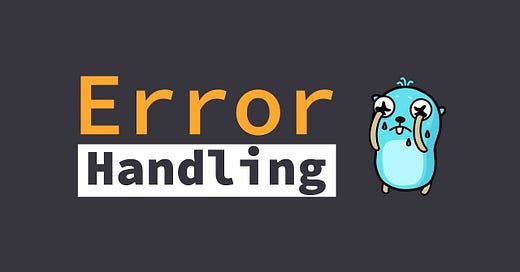Error Handling in Go and Gin: Best Practices with Working Example
When building robust web applications, error handling is a critical part. In Go, errors are explicit, means its need to handle manually and not in try and catch style. Gin provides helpful patterns to manage errors gracefully and consistently across your HTTP endpoints.
In this article, we will look on how to handle errors in a Gin API using middleware and also structured responses.
We will walk through an example on how to catch, handle, and return errors cleanly.
Why have Error Handling Matters?
When building APIs, you need to:
Respond with the correct HTTP status code
Provide clear error messages
Avoid exposing internal logic or stack traces
Handle unexpected errors in a centralized and consistent way
Without having proper error handling, users may receive confusing or inconsistent messages. Thus developers may struggle to debug the issues.
Let’s see Basic Error Handling Pattern in Gin
Gin provides the Context.Error(err) method to record an error during request processing. You can then use middleware to intercept and format the response appropriately.
Let’s go walk through a real example.
Here is Full Example Code
package main
import (
"errors"
"net/http"
"github.com/gin-gonic/gin"
)
func main() {
router := gin.Default()
// Global error handling middleware
router.Use(errorMiddleware())
// Example API endpoint
router.GET("/api/data", getDataHandler)
// Start the server
router.Run(":8080")
}
// errorMiddleware handles any errors that occur in handlers
func errorMiddleware() gin.HandlerFunc {
return func(c *gin.Context) {
c.Next() // Continue to next handler
// If any errors were recorded in context
if len(c.Errors) > 0 {
err := c.Errors.Last()
c.JSON(http.StatusInternalServerError, gin.H{
"error": err.Error(),
"code": "INTERNAL_ERROR",
})
}
}
}
// getDataHandler returns data or an error based on query
func getDataHandler(c *gin.Context) {
triggerError := c.Query("error") // Example: /api/data?error=true
if triggerError == "true" {
c.Error(errors.New("simulated handler error"))
return
}
c.JSON(http.StatusOK, gin.H{
"message": "Data retrieved successfully",
"data": []string{"item1", "item2", "item3"},
})
}Let’s understand How It Works?
1.Triggering an Error in the Handler
Inside getDataHandler, we simulate an error if the query parameter ?error=true is passed:
c.Error(errors.New("simulated handler error"))This doesn’t stop execution immediately, but it records the error for later processing by middleware.
2. Catching the Error with Middleware
The errorMiddleware runs after the main handler (c.Next() ensures this), and checks if any errors were recorded:
if len(c.Errors) > 0 {
err := c.Errors.Last()
c.JSON(http.StatusInternalServerError, gin.H{
"error": err.Error(),
"code": "INTERNAL_ERROR",
})
}If an error exists, it returns a JSON error response with status code 500 Internal Server Error.
3.Successful Response
If no error is triggered, the handler returns:
{
"message": "Data retrieved successfully",
"data": ["item1", "item2", "item3"]
}4.Error Response
If /api/data?error=true is accessed, the client receives:
{
"error": "simulated handler error",
"code": "INTERNAL_ERROR"
}Best Practices for Error Handling in Gin
Extending This Pattern
You can improve the above example by:
Adding custom error types with HTTP status codes
Logging errors to a file or external system
Mapping different errors to different response codes (e.g., 400, 404, 403)
Returning validation errors with detailed fields
Let’s Conclude
To handle errors cleanly and consistently is easy in Gin. In Gin you can centralize error logic, by using c.Error() and middleware, keep handlers simple, and improve both developer and user experience. This pattern scales well in large applications and is easy to test and maintain.




